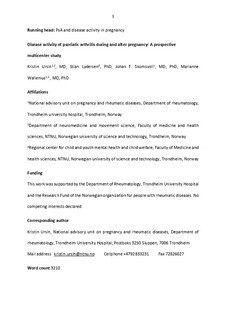Psoriatic arthritis disease activity during and after pregnancy: A prospective multicenter study
Journal article, Peer reviewed
Accepted version

Åpne
Permanent lenke
http://hdl.handle.net/11250/2645381Utgivelsesdato
2019Metadata
Vis full innførselSamlinger
Sammendrag
Objective
To study disease activity in women with peripheral psoriatic arthritis (PsA) during and after pregnancy. Previous knowledge on this topic is sparse.
Methods
The study included 108 pregnancies in 103 women with PsA from a Norwegian nationwide register. Disease activity was assessed prospectively at 7 time points before, throughout, and after pregnancy with the 3‐variable Disease Activity Score in 28 joints (DAS28) using C‐reactive protein levels and the Bath Ankylosing Spondylitis Disease Activity Index (BASDAI). Scores assessed at each time point were analyzed in a linear mixed model. We did additional analyses with “tumor necrosis factor inhibitor (TNFi) in pregnancy” as a covariate. The same statistical method was used to study self‐reported physical function, pain, and mental health.
Results
Approximately 75% of the women were in remission or had low disease activity during and after pregnancy according to the DAS28‐CRP score. Although disease activity was altogether stable, we found that it decreased in pregnancy and increased within 6 months postpartum. Disease activity at 6 months postpartum was significantly higher than at 6 weeks postpartum (mean DAS28‐CRP score 2.71 versus 2.45; P = 0.016). Women using TNFi in pregnancy had significantly lower disease activity than women not using TNFi (mean DAS28‐CRP score at 6 months postpartum 2.22 versus 2.72; P = 0.043). BASDAI scores were also low and stable during pregnancy but significantly higher at 6 months postpartum than at 6 weeks postpartum (mean BASDAI score 3.69 versus 2.95; P = 0.013).
Conclusion
Studying women with PsA, we found that disease activity was highest at 6 months postpartum but altogether low and stable in the period from planning pregnancy to 1 year after delivery. Women using TNFi in pregnancy had significantly lower disease activity.